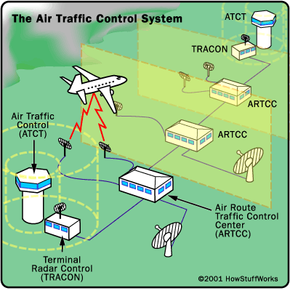- Get link
- X
- Other Apps
Air traffic control (ATC)
Air traffic control (ATC) is a critical component of the aviation industry, responsible for the safe and efficient movement of aircraft in the airspace. ATC personnel, commonly known as air traffic controllers, use a variety of tools and technologies to track and direct aircraft, ensuring that they maintain safe distances from one another and avoid collisions.
Air traffic controllers work in control towers at airports, as well as in air traffic control centers that manage airspace over large regions. They use radar, Automatic Dependent Surveillance-Broadcast (ADS-B), and other technologies to track the position, speed, and altitude of aircraft in real-time. They then use this information to issue instructions to pilots, such as altitude changes, routing, and landing instructions.
One of the key responsibilities of air traffic controllers is to ensure that aircraft maintain safe distances from one another. They do this by issuing instructions for aircraft to climb, descend, or change course as necessary. Controllers must also be able to make quick decisions and react quickly in case of an emergency.
How It works?
Air traffic control is divided into three different levels: terminal, en-route and oceanic. Terminal ATC is responsible for managing airspace around airports and typically includes the airspace from the ground to about 18,000 feet. En-route ATC manages airspace between airports, and typically includes airspace from 18,000 feet to about 60,000 feet. Oceanic ATC manages airspace over large bodies of water, such as oceans.
Air traffic controllers use a standardized system of phraseology to communicate with pilots, which is based on the ICAO standard language. It's designed to reduce the risk of miscommunication and to provide a clear and consistent message that's easy to understand.
Working as an air traffic controller is a demanding job that requires focus and attention to detail. It's a highly technical role that requires specialized training, including both classroom and on-the-job training. The training programs are designed to teach the controllers the technical skills they need to do their jobs, as well as the critical thinking and problem-solving skills that are essential for success in this field.
The job of an air traffic controller is considered to be very stressful, as it requires to be aware of multiple things at the same time and to make quick decisions in case of an emergency. The controllers have to work in shifts, sometimes in a high-stress environment and have to deal with different cultures and languages. Controllers are also subject to strict medical and psychological standards as they have to be able to perform their duties under high pressure.
Overall, air traffic control is a critical component of the aviation industry, responsible for ensuring the safe and efficient movement of aircraft in the airspace. Air traffic controllers use advanced technology and specialized training to track and direct aircraft, helping to keep the skies safe for all of us. The job requires a high level of concentration and decision-making, which makes it challenging and stressful, but also extremely rewarding for those who choose to pursue a career in this field.



Comments
Post a Comment